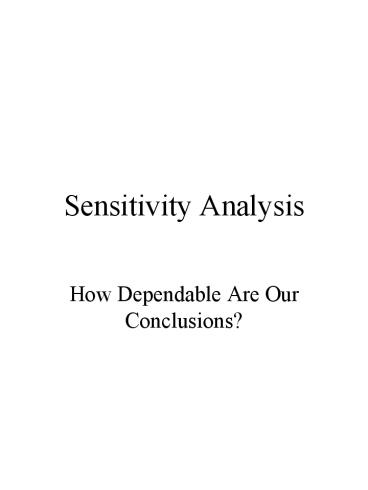Sensitivity Analysis PowerPoint PPT Presentation
1 / 13
Title: Sensitivity Analysis
1
Sensitivity Analysis
- How Dependable Are Our Conclusions?
2
Sensitivity Analysis
- Key Question How sensitive is the optimal
solution to the assumptions, estimates, or
constraints we have made in our modeling of the
problem? - This applies to
- Profit or Cost Estimates
- Restrictions on Time, Capacity, Budget
- Adding or Removing Restrictions
- Including Other Variables in Obj. Function
3
How Sensitive Is Our Solution To Changes In The
Profit Coefficients?
- Range of Optimality Range of values of profit
coefficients within which the optimal solution
remains unchanged. - The Wider the Range the Less Sensitive Our
Conclusions Are to Profit Coefficient Estimates. - The Optimal Value May Change However.
4
Time Allocation Example
- Max 5X110X2
- s.t. X1X2 lt 20 Hours
- X1 gt 10 Hours
- X2 gt 3 Hours
- Range of Optimality for 5X1
- -M to 10 Rating Points1
- Range of Optimality for 10X2
- 5 to M Rating Points1
- 1 Holding other parameters constant
5
How Much Would A Profit Coefficient Have To
Change To Take On A Value Above Its Lower bound?
- Reduced Costs
- The amount the profit coefficient of a variable
will have to increase before the decision
variable can increase beyond its lower bound
(usually 0). - The amount the optimal profit will change per
unit increase in the decision variable - Complementary Slackness indicates that at the
optimal solution either the decision variable is
at its lower bound or its reduced cost is 0.
6
Time Allocation Example Reduced Costs
- Because the optimal solution is X110 and X210
the reduced costs for their respective
coefficients are equal to 0 (both are above their
lower bound of 0). - What happens if we eliminate the constraint
X1gt10?
7
Time Allocation Example Modified
- Max 5X110X2
- s.t. X1X2 lt 20
- X2 gt 3
- Optimal Solution
- X1 0 and X2 20
- Reduced Costs for the X1 coefficient is now -5
points. This implies that the X1 coefficient must
increase by 5 points before we allocate any time
to X1 (Fun).
8
What Happens When We Make Changes To Our
Constraints?
- Any Changes We Make to Constraints that Effect
the Feasible Region May Change the Optimal
Solution. - Changing the RHS (right hand side) of a Binding
Constraint Will Change the Optimal Solution. - Changing the RHS of a Nonbinding Constraint Only
Effects Optimal Solution If the Changes Are
Greater Than the Corresponding Slack or Surplus.
9
Time Allocation Example Changing RHS Constraints
- Max 5X1X2
- s.t. X1X2 lt 20 (Binding)
- X1 gt 10 (Binding)
- X2 gt 3 (Nonbinding)
- gt Changing the RHS of the first 2 constraints
will effect the optimal solution. Increasing the
third constraint by more than 7 (surplus 7)
will alter optimal solution.
10
Time Allocation Example Changing RHS Constraints
- Case 1 X1X2 lt 21
- Optimal Solution X110 X211
- Case 2 X1 gt 9
- Optimal Solution X19 X211
- Case 3 X2 gt 10
- Optimal Solution X110 X210
- Case 4 X2 gt 11
- Infeasible Solution
11
How Do Changes In RHS Constraints Influence The
Obj. Function Value?
- Shadow Price The degree to which the optimal
objective function value will change per unit
increase in a RHS constraint. - Interpretation
- If costs are not included in the profit
coefficients (sunk costs) then we should be
willing to pay up to the shadow price per unit of
additional resource. - If costs are included then it represents the
incremental price we should pay above which we
are currently paying. - Complementary Slackness At optimal solution
either a constraint is satisfied with equality or
its shadow price0.
12
How Are Shadow Prices Impacted By Changes In RHS
Values?
- Range of Feasibility Set of RHS values for which
the shadow price for a given constraint remains
constant1. - The Set of Binding Constraints (the constraints
that determine the optimal solution) Remains
Constant For All RHS Values Within the Range of
Feasibility. - 1 Optimal solution and obj. function value will
change over this range.
13
Time Allocation Example Shadow Prices
- Max 5X110X2
- Shadow Price F.
Range - s.t. X1X2 lt 20 10 Pts. (13 to M)
- X1 gt 10 -5 Pts. (0 to 17)
- X2 gt 3 0 Pts. (-M to 10)
- InterpretationIn order- For values of RHS from
13 to M one unit changes in RHS change the obj.
function value by 10 points. For values of RHS
from 0 to 17 one unit changes in RHS result in a
-5 point change. For values of RHS from -M to 10
unit changes in RHS result in no obj, function
changes.

